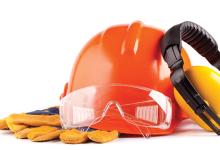
Risk to direct employees in quarries has been cut significantly in recent years but the potential for preventable accidents among contractors remains high. Claire Symes reports
Efforts to improve safety in quarries across Europe in recent years have seen the rate of reportable and lost time accidents driven down. While the way the figures are recorded across the continent varies, the effect of these initiatives is still clear.
Many companies have set themselves the target of zero lost time accidents and some have already achieved this with their direct employees. However, statistics and experience on site suggests that the safety improvements have not necessarily had the same effect on the accident rates among contractors.
In fact, contractors are believed to be the most at risk of serious accidents in the quarry site, particularly when involved in maintenance.
"The quarrying industry has been very successful in improving its health and safety record in recent years with initiatives being led both by the companies and their national associations," said
According to Isles, around three quarters of accidents that happen to contractors fall into three types and are all preventable. "The main accident types are manual handling; struck bys - either by a fixed or moving object; and slips, trips and falls," he said. "Most of these incidents could be avoided by better communication, more planning and improved housekeeping." Isles believes that the difference between the accident rate for direct employees and contractors is due to unfamiliarity with the work place and not being part of the in-house safety culture that has developed in most companies in recent years. "The key to reducing contractor accident rates starts with careful selection and control while on site to ensure they are both skilled for the work and are aware of their surroundings," said Isles.
"
"While the contractor may have carried out the same job in other quarries before, it is essential that a risk assessment and task audit of their work is carried out," said Isles. "This is especially true for maintenance operations - contractors need to have a clear understanding of the procedures for stopping machines during the work and ensuring everyone is clear before they are restarted.
"Training is a key element in improving understanding of risks and there is definitely more room for courses on this subject area," said Isles. "EPIC - the national training body for extraction and mineral processing industries in the UK - is currently looking up setting a course to provide training for managing of contractors.
"For the contractors themselves, EPIC has a safety passport scheme which shows a contractor has an awareness of safety issues, however, this does not mean that they are competent for the task." The problem of improving contractor safety is not a simple one but it is one that needs to be tackled if the industry is to achieve its long-term target of being accident free
Maintenance risks
Contractors working on maintaining quarry equipment are at the highest risk of accidents. "Contractors carrying out maintenance are often required to work at height, usually with difficult access," said Isles.
"On mobile equipment, manufacturers are beginning to move access points for daily monitoring to ground level but access to the machine for more in-depth checks and servicing can still be difficult. Inclined ladders and hand rails can reduce the risk of falls if it is not possible to provide ground level access.
"On stationary equipment, quarry owners need to think more about the safety during maintenance when specifying new machinery and not just accept the standard design.
"One of the of the Quarry Products Associations' Health & Safety Awards winners secured the accolade after modifying a new asphalt plant to reduce improve safety. A chute on the plant for transferring hot aggregates often used to block and the only way to get the plant working again was to rod the blockage from below placing the operative in the path of the falling stone. The site manager had a door fitted in the chute above where the blockage occurred so it could be cleared more safely from above.
"Manufacturers should design plants and equipment that is safe as standard but even if that is the case quarry operators still need to continually review procedures and operations to identify ways of further reducing the risk of accidents."








